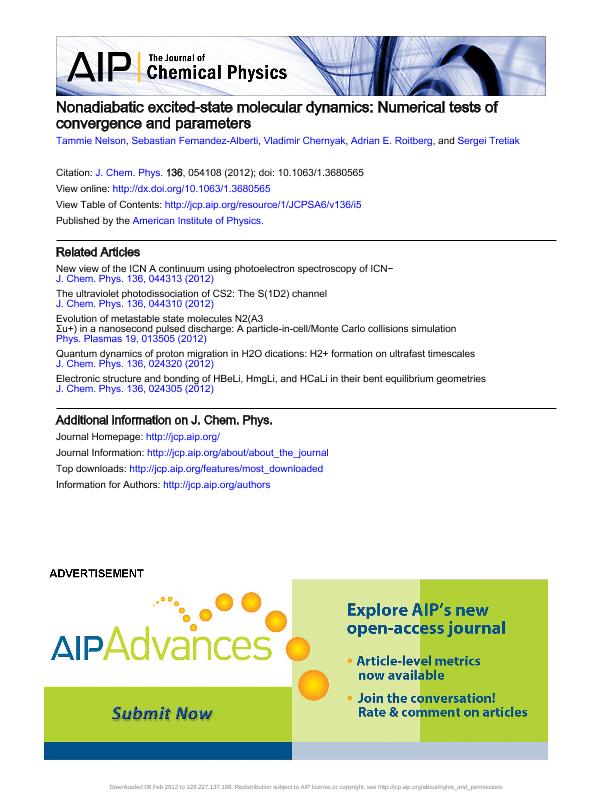Mostrar el registro sencillo del ítem
dc.contributor.author
Nelson, Tammie
dc.contributor.author
Fernández Alberti, Sebastián

dc.contributor.author
Chernyak, Vladimir
dc.contributor.author
Roitberg, Adrián

dc.contributor.author
Tretiak, Sergei

dc.date.available
2023-04-19T12:49:50Z
dc.date.issued
2012-01
dc.identifier.citation
Nelson, Tammie; Fernández Alberti, Sebastián; Chernyak, Vladimir; Roitberg, Adrián; Tretiak, Sergei; Nonadiabatic excited-state molecular dynamics: Numerical tests of convergence and parameters; American Institute of Physics; Journal of Chemical Physics; 136; 5; 1-2012
dc.identifier.issn
0021-9606
dc.identifier.uri
http://hdl.handle.net/11336/194503
dc.description.abstract
Nonadiabatic molecular dynamics simulations, involving multiple Born-Oppenheimer potential energy surfaces, often require a large number of independent trajectories in order to achieve the desired convergence of the results, and simulation relies on different parameters that should be tested and compared. In addition to influencing the speed of the simulation, the chosen parameters combined with the frequently reduced number of trajectories can sometimes lead to unanticipated changes in the accuracy of the simulated dynamics. We have previously developed a nonadiabatic excited state molecular dynamics methodology employing Tullys fewest switches surface hopping algorithm. In this study, we seek to investigate the impact of the number of trajectories and the various parameters on the simulation of the photoinduced dynamics of distyrylbenzene (a small oligomer of polyphenylene vinylene) within our developed framework. Various user-defined parameters are analyzed: classical and quantum integration time steps, the value of the friction coefficient for Langevin dynamics, and the initial seed used for stochastic thermostat and hopping algorithms. Common approximations such as reduced number of nonadiabatic coupling terms and the classical path approximation are also investigated. Our analysis shows that, at least for the considered molecular system, a minimum of ∼400 independent trajectories should be calculated in order to achieve statistical averaging necessary for convergence of the calculated relaxation timescales.
dc.format
application/pdf
dc.language.iso
eng
dc.publisher
American Institute of Physics

dc.rights
info:eu-repo/semantics/openAccess
dc.rights.uri
https://creativecommons.org/licenses/by-nc-sa/2.5/ar/
dc.subject
nonadiabatic molecular dynamics
dc.subject
excited states
dc.subject.classification
Físico-Química, Ciencia de los Polímeros, Electroquímica

dc.subject.classification
Ciencias Químicas

dc.subject.classification
CIENCIAS NATURALES Y EXACTAS

dc.title
Nonadiabatic excited-state molecular dynamics: Numerical tests of convergence and parameters
dc.type
info:eu-repo/semantics/article
dc.type
info:ar-repo/semantics/artículo
dc.type
info:eu-repo/semantics/publishedVersion
dc.date.updated
2023-04-18T13:11:56Z
dc.journal.volume
136
dc.journal.number
5
dc.journal.pais
Estados Unidos

dc.journal.ciudad
American Institute of Physics
dc.description.fil
Fil: Nelson, Tammie. Los Alamos National Laboratory; Estados Unidos
dc.description.fil
Fil: Fernández Alberti, Sebastián. Universidad Nacional de Quilmes; Argentina. Consejo Nacional de Investigaciones Científicas y Técnicas; Argentina
dc.description.fil
Fil: Chernyak, Vladimir. Wayne State University (wayne State University); Estados Unidos
dc.description.fil
Fil: Roitberg, Adrián. University of Florida; Estados Unidos
dc.description.fil
Fil: Tretiak, Sergei. Los Alamos National High Magnetic Field Laboratory; Estados Unidos
dc.journal.title
Journal of Chemical Physics

dc.relation.alternativeid
info:eu-repo/semantics/altIdentifier/url/https://aip.scitation.org/doi/full/10.1063/1.3680565
dc.relation.alternativeid
info:eu-repo/semantics/altIdentifier/doi/http://dx.doi.org/ 10.1063/1.3680565
Archivos asociados
